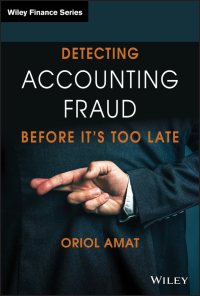
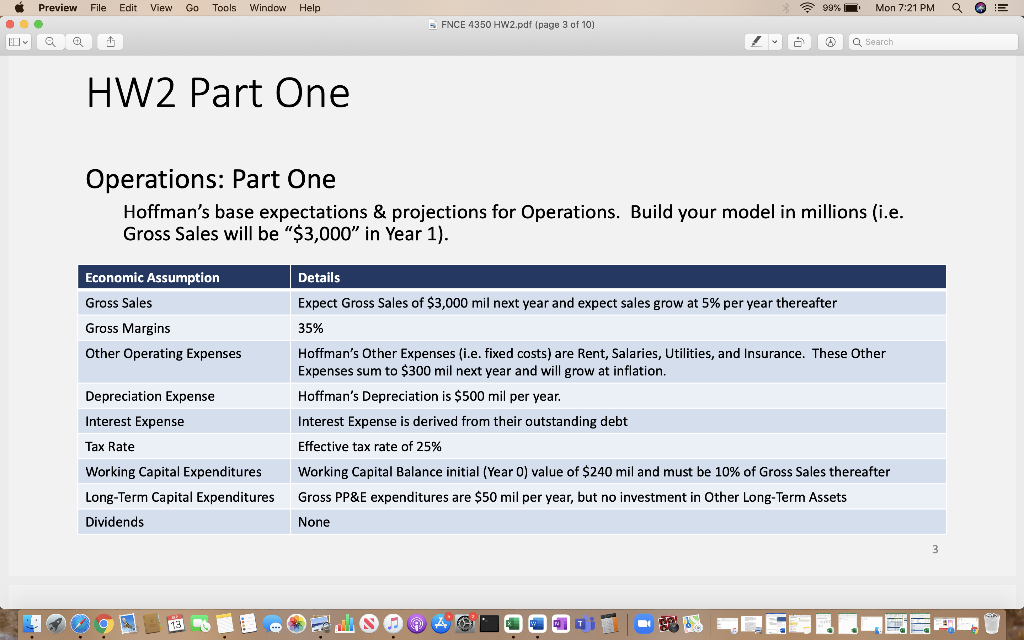
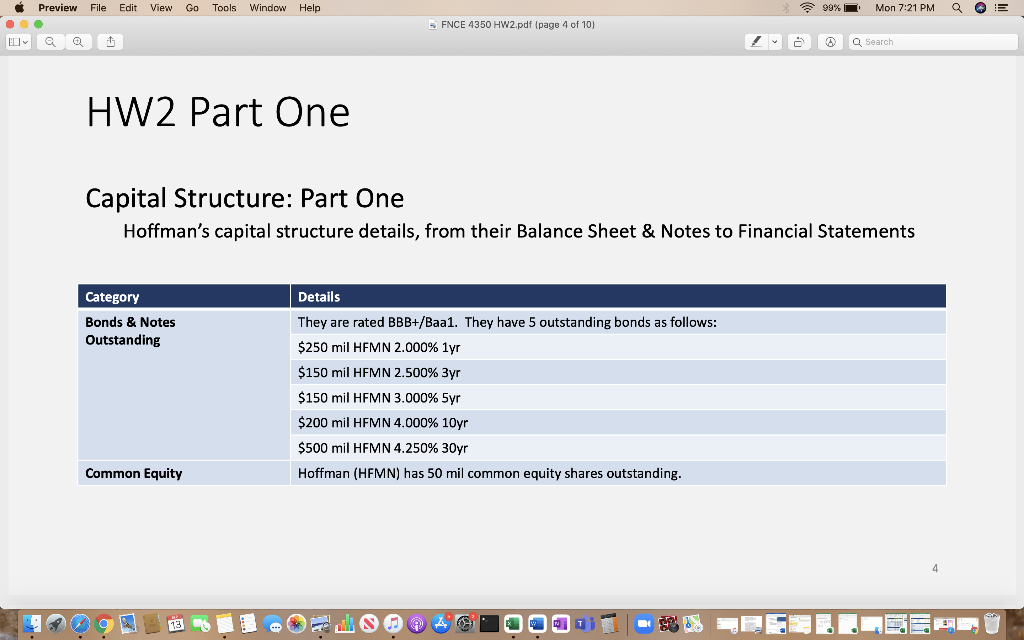
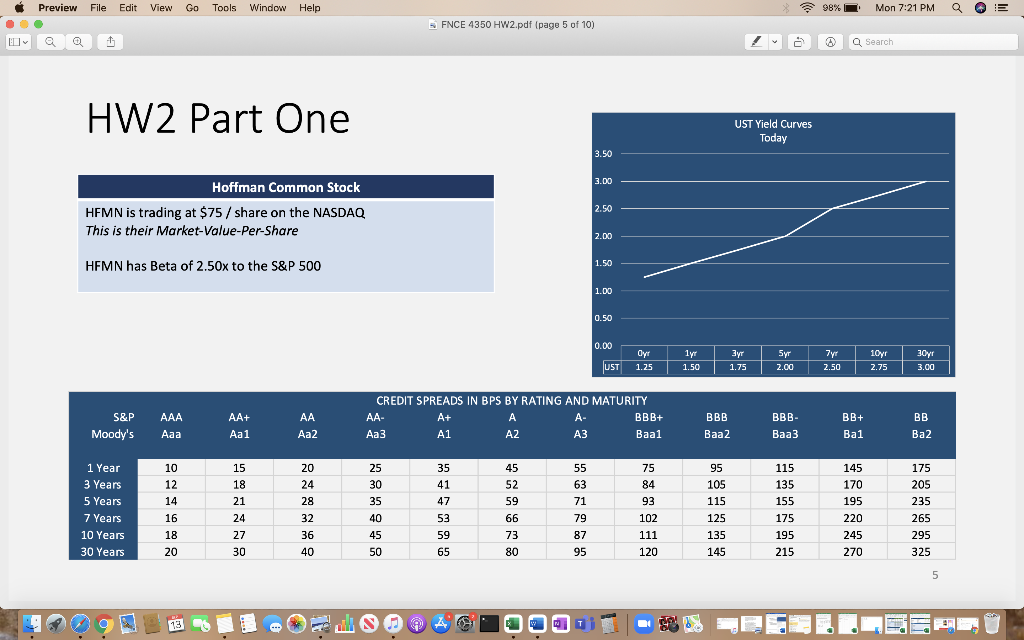
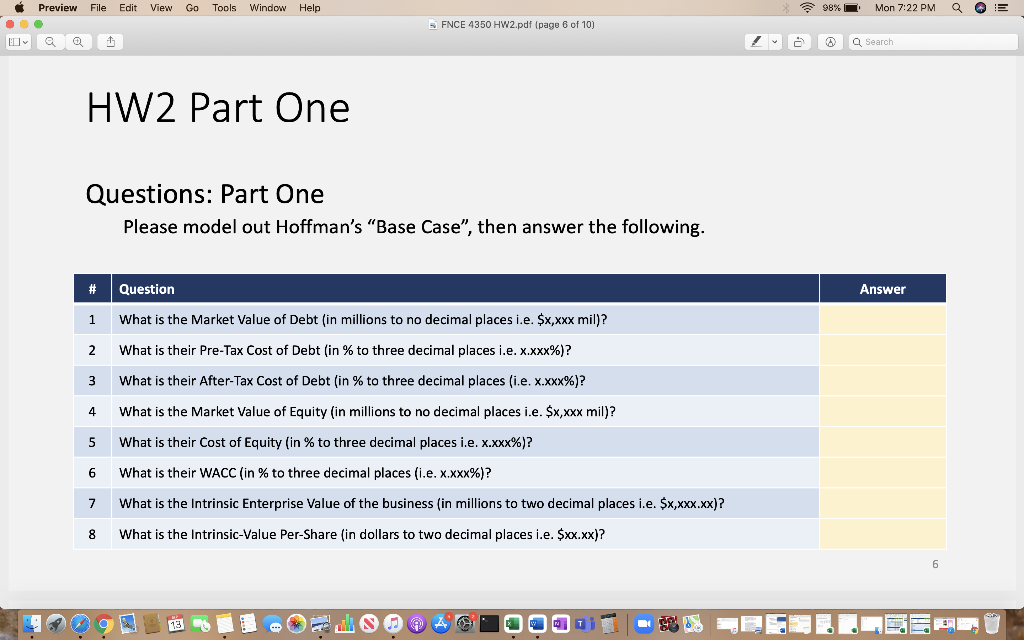
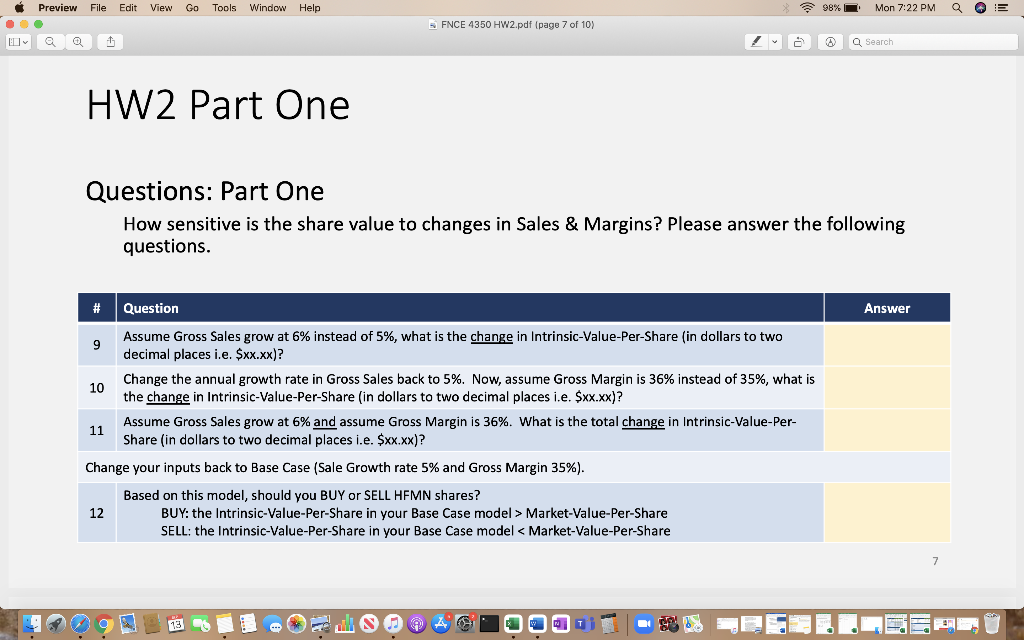
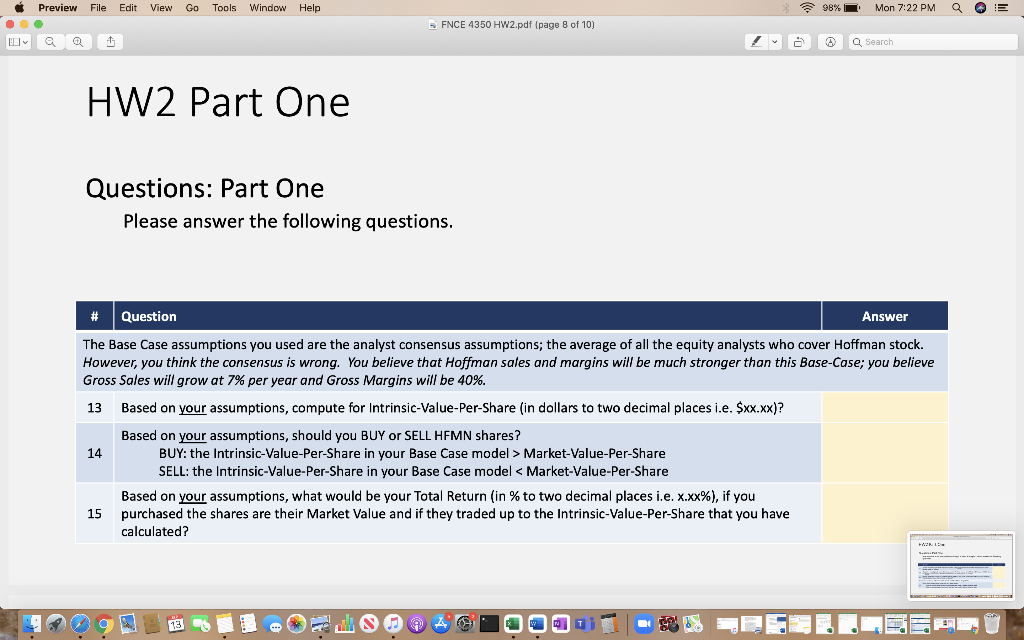
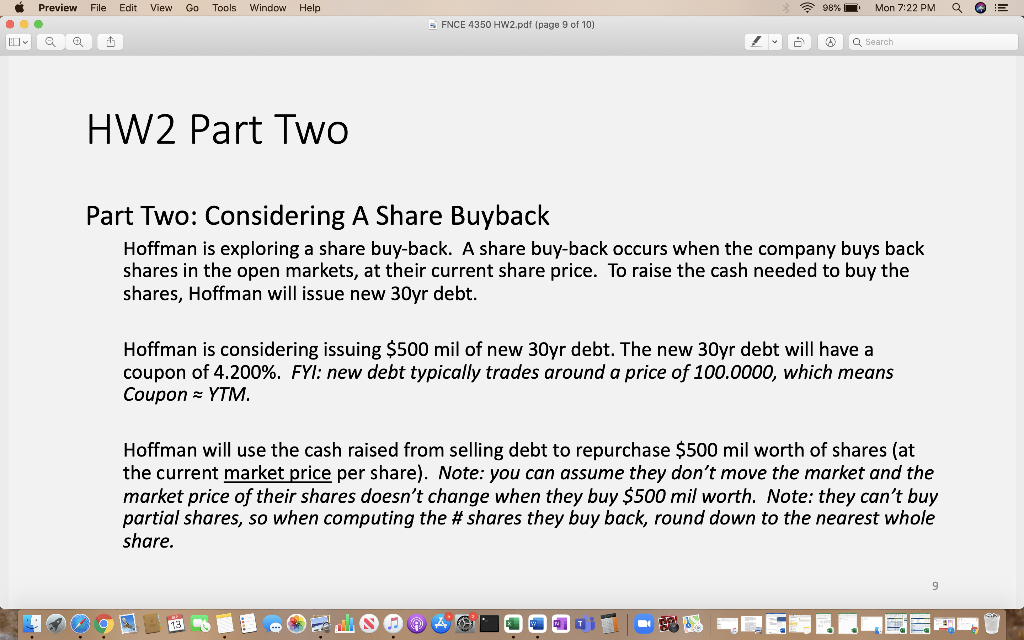
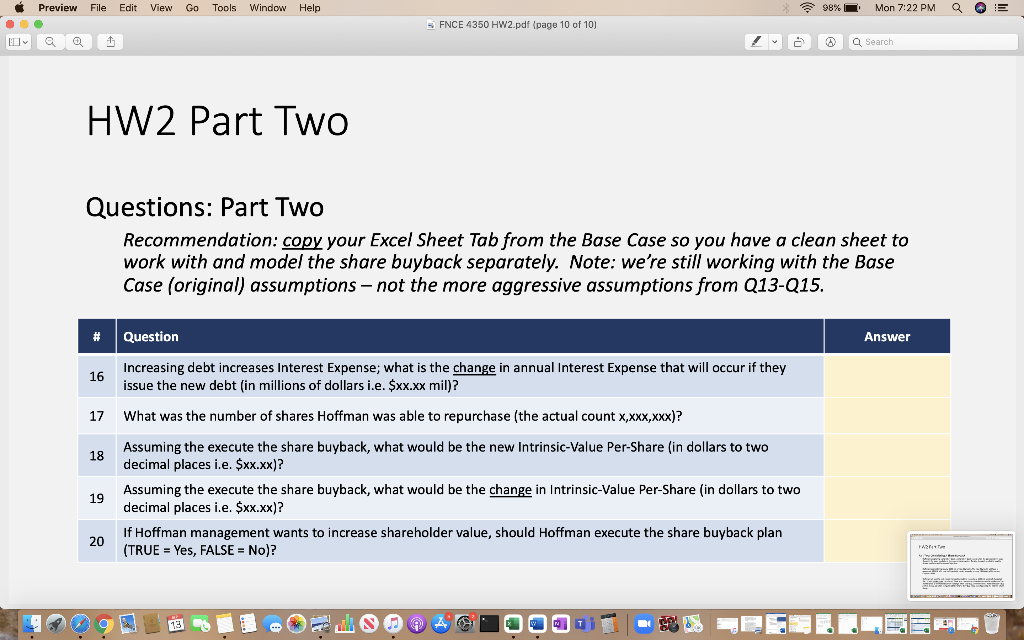
Preview File Edit View Go Tools Window Help 99% Mon 7:21 PM Q FNCE 4350 HW2.pdf (page 2 of 10) e Q Search HW2 Overview Overview We will model Hoffman Auto Body, a publicly-traded regional auto-repair company. In each case, we will compute Hoffman's intrinsic-value-per-share (the theoretical value per share, from our DCF model). Some key economic assumptions: Risk-Free Rate: 2.00% Assumed Return on Equity Market (on S&P 500): 10.00% Inflation: 2.50% Terminal Value: assume a long-term FCF growth rate of 3.50% 13 T Preview File Edit View Go Tools Window Help 99% Mon 7:21 PM Q FNCE 4350 HW2.pdf (page 3 of 10) @ Q Search HW2 Part One Operations: Part One Hoffman's base expectations & projections for Operations. Build your model in millions (i.e. Gross Sales will be "$3,000" in Year 1). Economic Assumption Gross Sales Gross Margins Other Operating Expenses Details Expect Gross Sales of $3,000 mil next year and expect sales grow at 5% per year thereafter 35% Depreciation Expense Interest Expense Hoffman's Other Expenses (i.e. fixed costs) are Rent, Salaries, Utilities, and Insurance. These Other Expenses sum to $300 mil next year and will grow at inflation. Hoffman's Depreciation is $500 mil per year. Interest Expense is derived from their outstanding debt Effective tax rate of 25% Working Capital Balance initial (Year O) value of $240 mil and must be 10% of Gross Sales thereafter Gross PP&E expenditures $50 mil per year, but no investment in Other Long-Term Assets None Tax Rate Working Capital Expenditures Long-Term Capital Expenditures Dividends 13 MT & Preview File Edit View Go Tools Window Help 99% Mon 7:21 PM Q FNCE 4350 HW2.pdf (page 4 of 10) @ Q Search HW2 Part One Capital Structure: Part One Hoffman's capital structure details, from their Balance Sheet & Notes to Financial Statements Category Bonds & Notes Outstanding Details They are rated BBB+/Baal. They have 5 outstanding bonds as follows: $250 mil HEMN 2.000% 1yr $150 mil HEMN 2.500% 3yr $150 mil HEMN 3.000% Syr $200 mil HEMN 4.000% 10yr $500 mil HEMN 4.250% 30yr Hoffman (HEMN) has 50 mil common equity shares outstanding. Common Equity 13 T Preview File Edit View Go Tools Window Help A 98% Mon 7:21 PM Q E FNCE 4350 HW2.pdf (page 5 of 10) e Q Search HW2 Part One UST Yield Curves Today 3.50 3.00 Hoffman Common Stock HEMN is trading at $75 / share on the NASDAQ This is their Market Value-Per-Share 2.50 2.00 HEMN has Beta of 2.50x to the S&P 500 1.50 1.00 0.50 0.00 Oyr 1yr 1.50 3y 1.75 Syr 2.00 7yr 2.50 10yr 2.75 JUST 30yr 3.00 1.25 AA S&P Moody's BBB AAA Aaa CREDIT SPREADS IN BPS BY RATING AND MATURITY . A+ A A- BBB+ Aa3 A1 AZ A3 Baal AA+ Aa1 BBB Baa2 BB+ Ba1 BB Ba2 Aa2 Baa3 10 12 14 15 18 21 75 84 92 1 Year 3 Years 5 Years 7 Years 10 Years 30 Years 115 135 155 20 24 28 32 36 40 25 30 35 40 45 50 35 41 47 53 59 65 55 63 71 79 87 45 52 59 66 73 80 95 105 115 125 135 145 145 170 195 220 245 270 175 205 235 265 295 325 16 18 20 24 27 30 102 111 120 175 195 215 95 5 13 T 1996 Preview File Edit View Go Tools Window Help 98% Mon 7:22 PM Q FNCE 4350 HW2.pdf (page 6 of 10) @ Q Search HW2 Part One Questions: Part One Please model out Hoffman's "Base Case", then answer the following. # Question Answer 1 What is the Market Value of Debt (in millions to no decimal places i.e. $x,xxx mil)? 2 What is their Pre-Tax Cost of Debt (in % to three decimal places i.e. x.xxx%)? 3 What is their After-Tax Cost of Debt (in % to three decimal places (i.e. x.xxx%)? 4 What is the Market Value of Equity (in millions to no decimal places i.e. $x,xxx mil)? 5 What is their Cost of Equity (in % to three decimal places i.e. x.xxx%)? 6 What is their WACC (in % to three decimal places (.e. x.xxx%)? 7 What is the intrinsic Enterprise Value of the business (in millions to two decimal places i.e. $x,xxx.xx)? 8 What is the intrinsic-Value Per-Share (in dollars to two decimal places i.e. $xx.xx)? 13 T 96 Preview File Edit View Go Tools Window Help 98% Mon 7:22 PM Q FNCE 4350 HW2.pdf (page 7 of 10) @ Q Search HW2 Part One Questions: Part One How sensitive is the share value to changes in Sales & Margins? Please answer the following questions. # Question Answer Assume Gross Sales grow at 6% instead of 5%, what is the change in Intrinsic-Value-Per-Share (in dollars to two 9 decimal places i.e. $xx.xx)? Change the annual growth rate in Gross Sales back to 5%. Now, assume Gross Margin is 36% instead of 35%, what is 10 the change in Intrinsic-Value-Per-Share (in dollars to two decimal places i.e. $xx.xx)? 11 Assume Gross Sales grow at 6% and assume Gross Margin is 36%. What is the total change in Intrinsic-Value-Per- Share (in dollars to two decimal places i.e. $xx.xx)? Change your inputs back to Base Case (Sale Growth rate 5% and Gross Margin 35%). Based on this model, should you BUY or SELL HEMN shares? 12 BUY: the Intrinsic-Value-Per-Share in your Base Case model > Market-Value-Per-Share SELL: the Intrinsic-Value-Per-Share in your Base Case model Market-Value-Per-Share SELL: the Intrinsic-Value-Per-Share in your Base Case model Market-Value-Per-Share SELL: the Intrinsic-Value-Per-Share in your Base Case model Market-Value-Per-Share SELL: the Intrinsic-Value-Per-Share in your Base Case model















